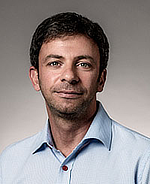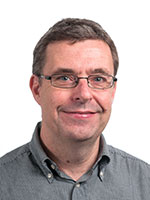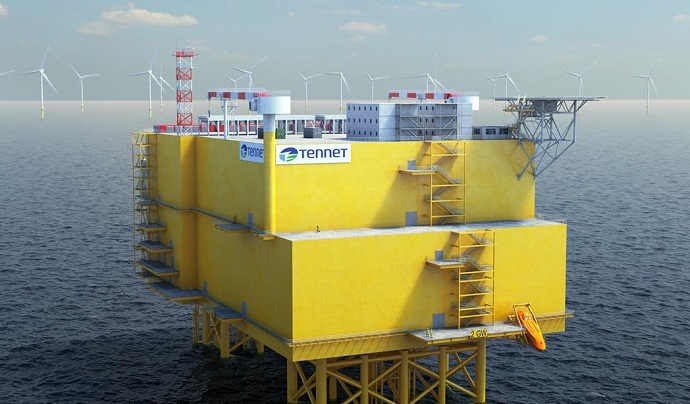Last year, Hitachi Energy signed the largest export order in Swedish history. The technology company is to deliver converters that will connect off-shore wind power to Germany and The Netherlands. How can power electronics play a role in the energy transition? Massimo Bongiorno, Professor at Chalmers University, claims that it already does.
The scene is the Mistra Electrification annual conference in 2022 and Massimo Bongiorno, Professor of Electric Power Engineering at Chalmers University addresses the delegates:
“Whatever you can do with mechanical systems, you can do with power electronics – and you can do it better.”
What did you mean by that?
“Ha-ha, I often say so,” said Massimo Bongiorno. “For example, a converter is an object that converts AC to DC power. But it can also release electrical energy to the grid. When it does, it acts in the same way as synchronous generators because it adds inertia to the grid. In that sense, power electronics can replace rotational mass.”

One of his goals is to find ways to maintain the overall stability of the power system. Historically, the power system was built on properties such as hydro power and later, nuclear power, where synchronous generators deliver the necessary inertia.
“But a system built on power electronics would be better and more effective, since it can add inertia, react faster when there are interferences, and enables optimisation. It is like having to brake a car if a child crosses the road: a driver needs to see the child, react, and then push the brake, while a self-driving car could stop faster,” said Massimo Bongiorno.
Today, wind power, solar power and batteries are all interfaced with power electronics to the grid. Since wind and solar power is increasing, we will see more of power electronics in the future, according to Massimo Bongiorno.
Hitachi Energy is one of the non-academic partners in Mistra Electrification. On March 30th last year, the technology company closed a deal with TenneT, the Dutch-German transmission system operator, to supply multiple off-shore and on-shore high-voltage direct current (HVDC) converter stations to connect off-shore wind farms to the Dutch and German grids.
According to Hitachi Energy, the deal confirms the opportunity to demonstrate how state-of-the-art technology can be deployed effectively and how new business models enable the scale needed for the green energy transition. The deal is worth 13 billion Euros, making it the largest export order in Swedish history, according to Dagens Nyheter.
The larger the share of renewable power in the power system, the lower the amount of inertia – if not supplied by power electronics. This is because the shares of hydro power and nuclear power using synchronous generators are reduced.
“Traditionally, transmission system operators (TSOs) have used synchronous condensers to stabilise the grids, aside from which synchronous generators and the synchronous condensers provide mechanical inertia” said Jan R. Svensson, Adjunct Professor at Chalmers and Research Fellow at Hitachi Energy Research. “However, when the electricity demand increases with the energy transition, the industry develops to meet the demand. This is what is happening now when it comes to power electronics. The TSO’s see they can buy services such as inertia from grid-connected converters.”

If power electronics can replace synchronous generators, why isn’t it used more frequently?
“Remember that this is a new area in which power electronics manufacturers have just launched their products,” said Jan R. Svensson. “As always, there are pros and cons. If a failure arises in the grid, the synchronous condenser is helping to stabilise the system by supplying inertia and high fault current. If a converter will supply the same level of fault current as a synchronous condenser, it needs to be over-dimensioned, which is costly. On the other hand, the controllability of the converter is much better, the flexibility is much greater, and it needs less maintenance. Moreover, the idle losses are lower.”
The research led by Massimo Bongiorno within Mistra Electrification is about how converters can be designed to minimise costs and optimise them for different applications.
“A converter can be combined in different ways; it is like building Lego. We are trying to find out how we can minimise active effect losses. They can be up to a percentage of the power, which doesn’t sound like much, but in the end is a lot of money spent on losses,” said Massimo Bongiorno.
Another challenge is the size of power electronics. A battery and converters that interface, for example, between a wind farm and the grid, can be the size of a building.
“If we could build power electronics more compactly, it would save cost. Furthermore, large appliances like that imply challenges if they need to be installed in urban areas”, said Massimo Bongiorno.
People might look upon power electronics as science fiction. What do you say when facing that? “Research is very much in the forefront, so I can sympathise with that perception,” said Massimo Bongiorno. “But as I mentioned earlier, power electronics is already a part of the grid. Just because we once were dependent upon synchronous generators it doesn’t mean that we need or want a system like that in the future. In the end, it is a matter of cost, and minimising the cost is one part of our research. But it is a fact that we will see more of power electronics in the future,” said Massimo Bongiorno.
This text is part of the Mistra Electrification Annual Report 2023. The full report can be found here.

